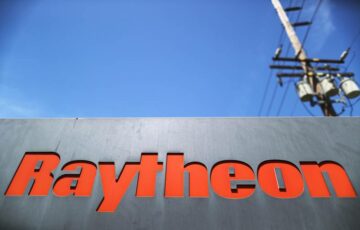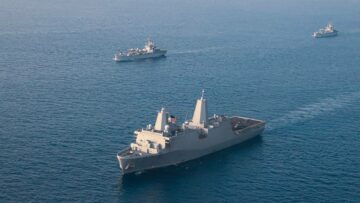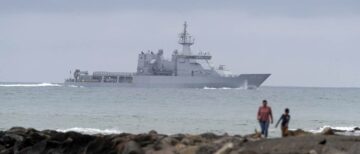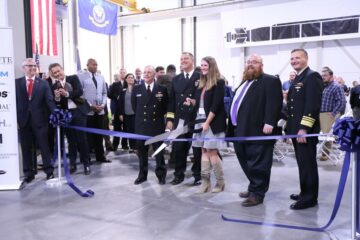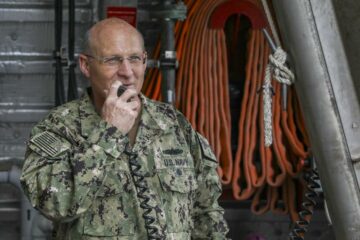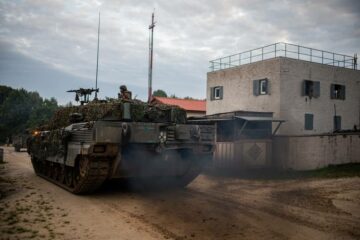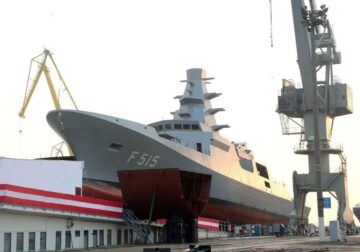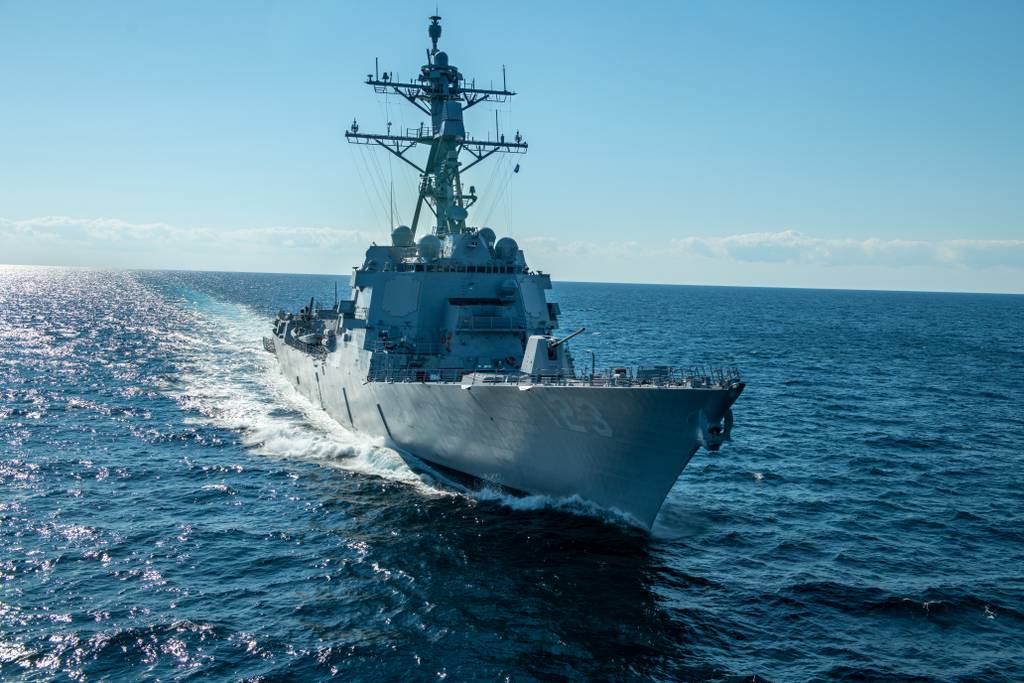
NEW YORK — The U.S. Navy is not in a hurry to move onto the next-generation destroyer program, dubbed DDG(X), but will instead wait until a design and the underlying technology is ready, the service secretary said.
As a result, “we probably will continue to build DDG Flight IIIs for a long period of time,” Carlos Del Toro said of the current program of record.
Del Toro told Defense News on Dec. 8 that he’s trying to bring “good discipline” to the Navy’s major acquisition programs, ensuring better cost estimates up front and maturing key components in the lab before committing to buying and fielding a platform.
‘Tremendous discipline’
The Navy is eyeing three major new programs whose timing, as previously outlined by the Navy, would have created a pileup of cost and risk for the service in the early 2030s. The service needs a DDG(X) to replace today’s Arleigh Burke-class destroyers; an SSN(X) to replace today’s Virginia-class attack submarines; and a Next Generation Air Dominance fighter to replace today’s F/A-18E/F Super Hornets.
The programs were previously on track to enter design and construction in that order — the DDG(X) in fiscal 2028, SSN(X) in FY31 and NGAD sometime in the 2030s — but Del Toro said the service would not move on an artificial timeline, instead waiting until the technology is right.
Now, it’s unclear which would hit the fleet first.
“I think there’s a lot to be determined yet on whether it is going to be DDG(X), SSN(X) or NGAD. But we’ve made enormous investments obviously in F-35 [Joint Strike Fighters], and we’ve seen the lessons of F-35 that’s been in development for … 20-plus years now,” Del Toro said. “So let’s be realistic about how fast we should move forward before we’re ready to commit to a major ACAT I program like that,” he added, referring to the largest and most complex defense acquisition programs.
He noted that the Flight III Arleigh Burke destroyers, the first of which is nearing completion at the Ingalls Shipbuilding yard in Mississippi, has an upgraded radar and combat system compared to previous flights of the ship. But the hull itself is running out of space and power-generation capacity, limiting the Navy’s ability to field new power-hungry sensors and weapons.
Del Toro cautioned against seeking a “transformational destroyer” design — akin to what the Navy did in the 1990s and early 2000s with the Zumwalt-class destroyer — and expressed his preference for something that more closely resembled the Burkes.
For all three upcoming development programs, he does not want the Navy to move ahead until “we have design maturity on these platforms,” despite any timelines already penciled into Navy long-range shipbuilding plans.
“That takes tremendous discipline on our part not to rush to production, at a time that our stakeholders sometimes are applying a tremendous amount of pressure because they want jobs in their districts, etc., etc., etc. And so it’s going to take a lot of compromise, a lot of balance to come up with the right answers, but I’m all for testing these technologies out on land-based facilities, for example,” before signing contracts for new ships and planes, he explained.
Though Del Toro said it would be prudent to continue Arleigh Burke Flight III construction until the DDG(X) is mature enough to enter production, that plan is not without some risk.
Industry involvement
The Navy planned to buy two destroyers per year for the next several years, and it requested authority from Congress to sign a five-year contract with General Dynamics’ Bath Iron Works and HII’s Ingalls Shipbuilding for nine ships with an option for a 10th, spanning FY23-FY27.
Instead, lawmakers on Dec. 8 passed a National Defense Authorization Act that allows the Navy to buy as many as three ships a year during that time frame.
But Del Toro is unconvinced the industrial base has the capacity to do that.
He said industry is churning out an average of 1.8 destroyers annually, and that includes schedule delays created early in the COVID-19 pandemic, as well as some ongoing labor and supply challenges. He emphasized that this isn’t just the case for the two shipyards but also a problem for companies throughout the vendor base that supply parts and government-furnished equipment, like the SPY-6 radar, at the heart of the Flight III upgrade.
For example, Bath Iron Works-built destroyer Carl M. Levin on Dec. 9 completed its acceptance trials, among the last steps before delivery to the Navy. That ship was expected to deliver in FY21.
The FY23 NDAA bill includes $250 million to strengthen the surface ship industrial base — though the secretary noted that money is at risk as Congress continues to pass continuing resolutions to fund the government instead of proper defense appropriations. Furthermore, companies must invest their own money in capital improvements to make three-a-year construction rates possible, Del Toro said. For now, he explained, building three a year will be a challenge.
Despite these challenges, Del Toro said he’s excited to see record levels of investments in shipbuilding, including the largest-ever request of $27 billion for FY23 that’s awaiting passage by congressional appropriators.
Del Toro said 54 ships are in construction now, “and more importantly than just the number of ships under construction, they’re the right ships under construction. So we’re building DDG Flight IIIs. We’re building aircraft carriers. … We’re building logistics ships, oilers that are incredibly important. So all these are really, really significant ships, and I’m proud of the investment that both President [Joe] Biden and Secretary [of Defense Lloyd] Austin have made in our shipbuilding accounts.”
Megan Eckstein is the naval warfare reporter at Defense News. She has covered military news since 2009, with a focus on U.S. Navy and Marine Corps operations, acquisition programs and budgets. She has reported from four geographic fleets and is happiest when she’s filing stories from a ship. Megan is a University of Maryland alumna.
- SEO Powered Content & PR Distribution. Get Amplified Today.
- Platoblockchain. Web3 Metaverse Intelligence. Knowledge Amplified. Access Here.
- Source: https://www.defensenews.com/naval/2022/12/12/us-navy-secretary-sees-no-need-to-rush-next-gen-destroyer-program/
- 1
- 10
- 11
- 2022
- 70
- 9
- a
- ability
- About
- acceptance
- Accounts
- achieved
- acquisition
- added
- against
- ahead
- AIR
- aircraft
- All
- allows
- already
- among
- amount
- and
- Annually
- answers
- Applying
- appropriations
- artificial
- attack
- authority
- authorization
- average
- awaiting
- Balance
- base
- because
- before
- Beginning
- Better
- biden
- Bill
- Billion
- bring
- Budgets
- build
- Building
- buy
- Buying
- Capacity
- capital
- carriers
- case
- challenge
- challenges
- closely
- combat
- come
- commit
- committing
- Companies
- compared
- Completed
- completion
- complex
- components
- compromise
- Configuration
- Congress
- Congressional
- construction
- continue
- continues
- continuing
- contract
- contracts
- Cost
- covered
- COVID-19
- COVID-19 pandemic
- created
- Current
- Defense
- delays
- deliver
- delivery
- Design
- Despite
- determined
- Development
- DID
- Dominance
- dubbed
- during
- Early
- emphasized
- enormous
- enough
- ensuring
- Enter
- equipment
- estimates
- etc
- example
- excited
- expected
- explained
- expressed
- FAST
- field
- fighters
- Filing
- First
- Fiscal
- FLEET
- flight
- Flights
- Focus
- Forward
- FRAME
- from
- front
- fund
- Furthermore
- General
- generation
- geographic
- going
- Government
- Heart
- Hit
- How
- HTTPS
- images
- important
- improvements
- in
- includes
- Including
- incredibly
- industrial
- industry
- instead
- Invest
- investment
- Investments
- IT
- itself
- jack
- Jan
- Jobs
- Key
- lab
- labor
- largest
- Last
- lawmakers
- Lessons
- levels
- logistics
- Long
- Lot
- made
- major
- make
- many
- Maryland
- mature
- maturity
- milestone
- Military
- million
- money
- more
- most
- move
- National
- Need
- needs
- New
- news
- next
- next-generation
- noted
- number
- Oilers
- ongoing
- Operations
- Option
- order
- outlined
- own
- pandemic
- part
- parts
- passed
- period
- plan
- planned
- plans
- platform
- Platforms
- plato
- Plato Data Intelligence
- PlatoData
- possible
- president
- pressure
- previous
- previously
- probably
- Problem
- Production
- Program
- Programs
- proper
- proud
- radar
- Rates
- ready
- realistic
- record
- replace
- Reported
- reporter
- request
- result
- Risk
- running
- rush
- Said
- schedule
- seeking
- sees
- sensors
- service
- several
- ships
- should
- sign
- significant
- signing
- since
- So
- some
- something
- Space
- stakeholders
- Steps
- Stories
- Strengthen
- strike
- Super
- supply
- Surface
- system
- Systems
- Take
- takes
- Technologies
- Technology
- test
- Testing
- The
- their
- three
- throughout
- time
- timeline
- timing
- to
- today’s
- track
- tremendous
- trials
- u.s.
- under
- underlying
- university
- upcoming
- upgrade
- upgraded
- us
- vendor
- wait
- Waiting
- Weapons
- What
- whether
- which
- will
- without
- works
- would
- X
- year
- years
- zephyrnet


